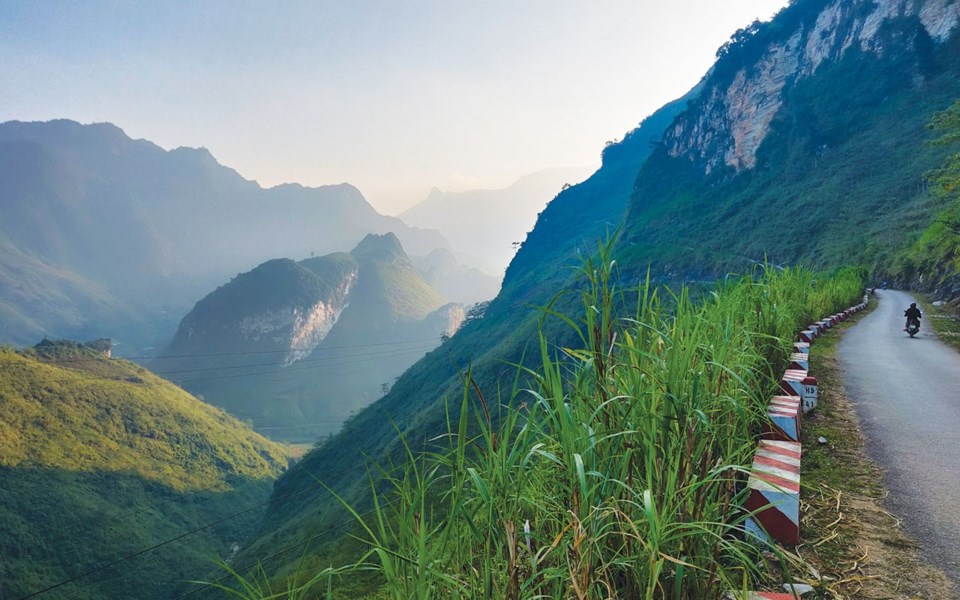I hear a horn honk and dutifully return the courtesy with a couple of blasts from the thumb trigger on my handlebar. Blind corners on single-lane roads can be dangerous, the exact reason why approaching them often turns into this noisy exchange. Slowing down and taking the corner wide, another motorcycle whizzes by my own and the rider speeds off towards her destination. The straightaway ahead is devoid of vehicles so I stomp the gear shifter down and give the throttle a twist, the engine underneath me whining as the bike accelerates. A cool wind licks my face, a gentle vibration purrs through the grips into my hands and my heart rate jumps a notch as I lay the bike over through another sweeping curve.
Beyond the roadside barrier, the terrain drops off into a steep canyon. At the bottom a river snakes through a gorge, its vertical walls rising out of the Earth like pillars. The sun dips on the horizon, mountain peaks illuminated in a golden glow. My partner and I pull over, flick out our kickstands and dismount to make as much of this amazing moment as we can. After a few minutes of wordless appreciation and a handful of photos (plus a couple of team selfies), we don our helmets and fire up the engines once more.
Motorcycles have been romanticized in film for generations, from the freedom felt on Peter Fonda's Chopper in Easy Rider (1969) to the companionship strengthened between Ernesto (Che) Guevara and Alberto Granado aboard their Norton 500 nicknamed "La Poderosa" ("The Mighty One") in 2004's The Motorcycle Diaries. During the Beat Generation, the vehicle quickly became a symbol of rebellion with the likes of James Dean and Marlon Brando brandishing Triumph motorcycles in their roles and lifestyles.
The rebel image may have worn off in 2019, but the thrill of riding a motorcycle is no less powerful now than it was a hundred years ago. On the flip side, motorcycles can also be one of the most dangerous forms of transportation. Ask any ER nurse and they will likely have more than a handful of stories of motorcyclists getting scraped up off the pavement and surgeons doing their best to stitch them back together.
The National Highway Traffic Safety Administration (NHTSA) in the U.S. reported in 2013 that per vehicle mile travelled (1.6 kilometres), motorcyclist fatalities occurred 26 times more frequently than passenger car occupant fatalities in traffic crashes. My own brother once balked at the idea of skiing in off-piste terrain for fear of hitting a tree, Sonny Bono style. I reminded him that time that he was commuting to work daily on a motorcycle through busy city traffic. He got the point.
While I'll refrain from encouraging people to take up road motorcycling as a recreational hobby or form of transport, when travelling to more remote parts of the world it can transform the experience entirely. I loathe tour buses and crowded coaches as much as any other traveller, when you end up exiting the vehicle only for bathroom breaks and designated tourist-trap stops. Driving a motorcycle on unfamiliar roads in an unfam iliar country actually makes the motorized travel more than just linking two points on a map, it makes the ride itself a memorable part of the travel experience. See a deserted view point on the highway shoulder? Passing through an intriguing, off-the-map village and want to stop for lunch? Want to see what's down that dirt road into the next valley? On a motorcycle, the opportunity for unique travel moments increases exponentially.
It's not all peaches and cream though. Experienced moto tourers all have their stories of challenging days riding through rainstorms, navigating flooded roads, or worse, coming off their motorcycle at speed. One has to accept the risks to reap the rewards.
The moment of realization that this was my new favourite mode of travel came last November during a trip to Vietnam. The roughly four-day, 400-kilometre Ha Giang Loop in the northern Vietnamese province of the same name boasts some of the most captivating road scenery and mountain passes in South East Asia. There's stuff to see around the villages and natural landscape attractions, but it's the ride that people remember the most fondly. The spike in tourism to Ha Giang in recent years has led to dozens of motorcycle rental companies opening up shop and the government has invested in road improvements, but the occasional washed out gravel corner reminds riders that it isn't Le Mans. In many places the road is exposed to ravines, so anyone with a sense of self preservation learns to slow down and take their time. That gives you more time to appreciate the view anyway.
Riding a motorcycle isn't hard, nor does it need to be dangerous. If you are interested in moto touring, it's worth taking a motorcycle safety course and getting the Class 6 licence. Authorities in many countries—as well as some motorbike rental companies—will ask you for an International Driving Permit (available from BCAA), so it's best to obtain this prior to departure to avoid roadside shakedowns by police.
Now, where next to ride?
Vince Shuley's first motorcycle was a well-worn 1969 Kawasaki TR90. For questions, comments or suggestions for The Outsider email [email protected] or Instagram @whis_vince.




